Moments in History: William Hunter's British Medals
10 March 2016 – 27 August 2017
Hunterian Art Gallery
Admission free
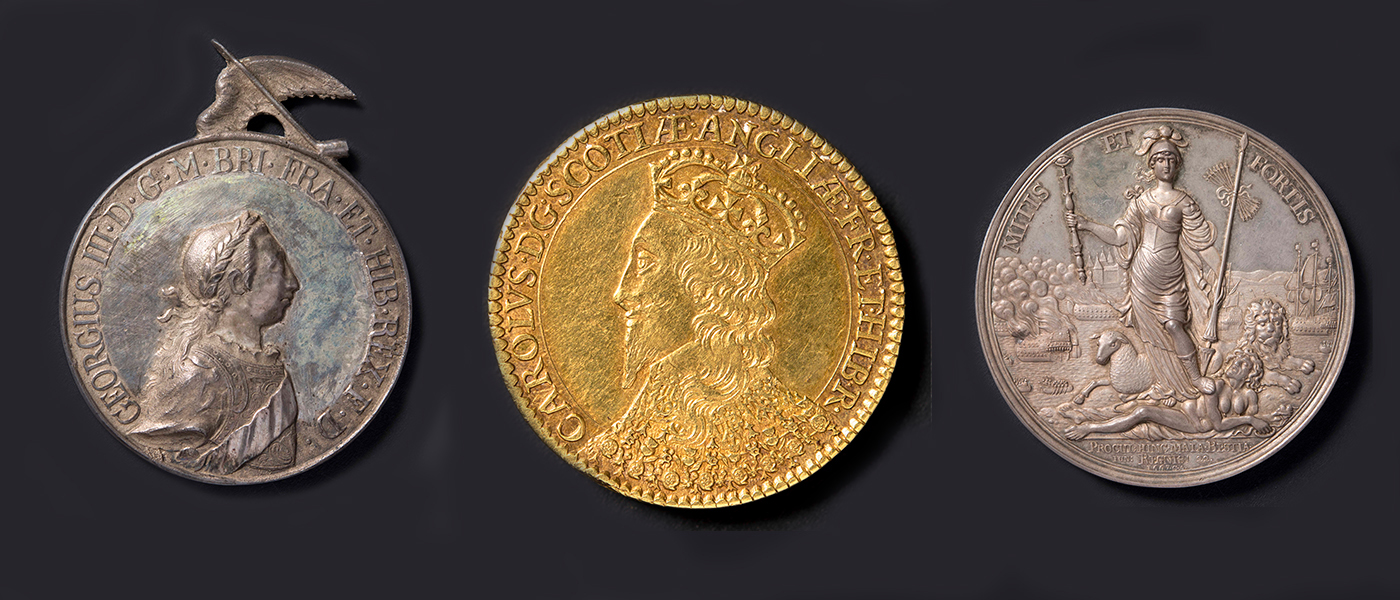
Introduction
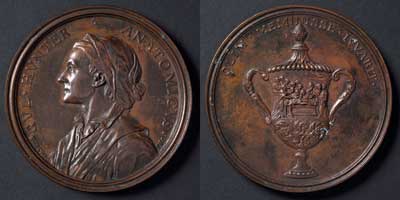 Medals are just one artistic medium through which an individual or event can be remembered, celebrated, or even satirised and used as propaganda.
Medals are just one artistic medium through which an individual or event can be remembered, celebrated, or even satirised and used as propaganda.
One of the Enlightenment’s pioneering medical and scientific figures was Dr William Hunter (1718 – 1783), whose extraordinary collections are the foundation of The Hunterian. This is the first ever exhibition dedicated to exploring British medals acquired by Hunter in the last thirteen years of his life.
Hunter collected for pleasure, but he also saw the potential that medals could play in what he described as ‘the illustration and confirmation of history’. He believed passionately that the continued expansion of his collection was a public duty, and that when the time came for the items to be donated to the University of Glasgow upon his death, they were to be used ‘for the improvement of knowledge’.
Objects of Desire
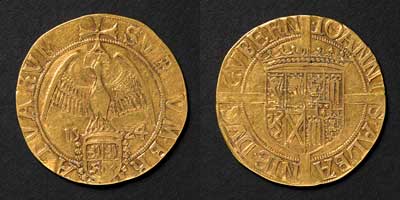 Hunter acquired his British medals between 1770 and 1783. They were obtained at auction, through donations and by means of contacts in Europe. Whole collections were also purchased outright. Hunter was quite willing to sell duplicates to fund further acquisitions. His collection of coins and medals was described at the time as being second only to the French Royal Cabinet.
Hunter acquired his British medals between 1770 and 1783. They were obtained at auction, through donations and by means of contacts in Europe. Whole collections were also purchased outright. Hunter was quite willing to sell duplicates to fund further acquisitions. His collection of coins and medals was described at the time as being second only to the French Royal Cabinet.
Chasing Immortality
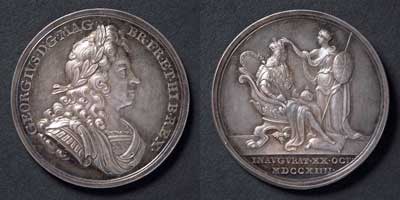 Just as today, royal events were keenly followed by the public. Medals recorded these occasions, commemorating coronations and marriages, but they could also be used for political comment, satire, propaganda and protest. Kings, queens, princes and princesses recognised the power of medals as a form of chasing immortality. Cast or struck in precious metals or cheaper alternatives like bronze, medals would help them to be remembered in the centuries to come, celebrate their achievements and glorify the pomp and ceremony that was an integral part of royal life.
Just as today, royal events were keenly followed by the public. Medals recorded these occasions, commemorating coronations and marriages, but they could also be used for political comment, satire, propaganda and protest. Kings, queens, princes and princesses recognised the power of medals as a form of chasing immortality. Cast or struck in precious metals or cheaper alternatives like bronze, medals would help them to be remembered in the centuries to come, celebrate their achievements and glorify the pomp and ceremony that was an integral part of royal life.
The Toils of War
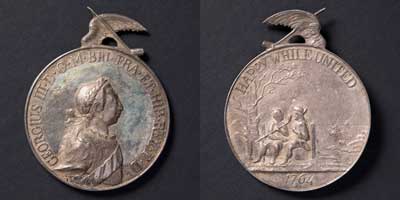 The Tudor age (1485 – 1603) was a defining era of British military history. Colonies were established in North America; the Royal Navy created; wars against France, Scotland, Ireland and Spain challenged the balance of power in Europe and at home. The Stuart era (1603 – 1714) witnessed three devastating civil wars that tore the nation apart, with further conflict in the Anglo-Dutch wars between 1652 and 1674. Finally, the Georgian period (1714 – 1830) propelled Britain into the Industrial Revolution and established the nation as the dominant military power in the world. Continual colonial expansion saw Britain fight wars in North America, India, Australasia, Africa and Europe. There were also bitter conflicts closer to home: the Jacobite Risings and the crushing of any last Stuart hopes of regaining the crown.
The Tudor age (1485 – 1603) was a defining era of British military history. Colonies were established in North America; the Royal Navy created; wars against France, Scotland, Ireland and Spain challenged the balance of power in Europe and at home. The Stuart era (1603 – 1714) witnessed three devastating civil wars that tore the nation apart, with further conflict in the Anglo-Dutch wars between 1652 and 1674. Finally, the Georgian period (1714 – 1830) propelled Britain into the Industrial Revolution and established the nation as the dominant military power in the world. Continual colonial expansion saw Britain fight wars in North America, India, Australasia, Africa and Europe. There were also bitter conflicts closer to home: the Jacobite Risings and the crushing of any last Stuart hopes of regaining the crown.
Off With Their Heads!
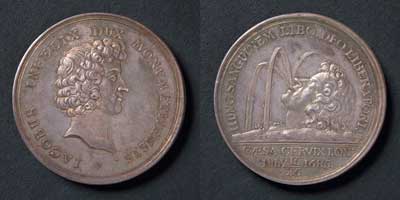 Death was an ever-present part of life during the Tudor, Stuart and Georgian eras. Life expectancy was low. Disease and illness were rife; plagues took their toll. Wars at home and abroad exacted innumerable casualties. Executions were commonplace and those of well-known people were always attended by large crowds, thronging to see the final grisly act. The killings of more famous individuals, particularly those deemed traitors, were commemorated on medals which did not hold back on the gore.
Death was an ever-present part of life during the Tudor, Stuart and Georgian eras. Life expectancy was low. Disease and illness were rife; plagues took their toll. Wars at home and abroad exacted innumerable casualties. Executions were commonplace and those of well-known people were always attended by large crowds, thronging to see the final grisly act. The killings of more famous individuals, particularly those deemed traitors, were commemorated on medals which did not hold back on the gore.
Improvement of Knowledge
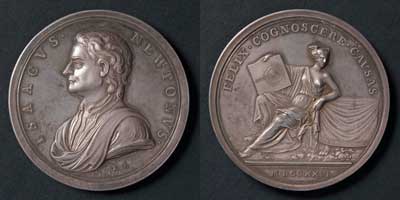 Before the 18th century, relatively few British medals commemorated the arts and sciences. The majority depicted royal, political or religious subjects, or military victories at home and abroad. The Enlightenment ushered in new ways of thinking and values. The arts and sciences flourished, and the remarkable diversity of Britain’s cultural and intellectual life was actively celebrated. This was reflected in many art forms, including medals, with actors, writers, scientists, artists, inventors, lecturers and doctors all being immortalised. This was also the age of great collecting, with William Hunter at the forefront of this movement, dedicated to the ‘improvement of knowledge’.
Before the 18th century, relatively few British medals commemorated the arts and sciences. The majority depicted royal, political or religious subjects, or military victories at home and abroad. The Enlightenment ushered in new ways of thinking and values. The arts and sciences flourished, and the remarkable diversity of Britain’s cultural and intellectual life was actively celebrated. This was reflected in many art forms, including medals, with actors, writers, scientists, artists, inventors, lecturers and doctors all being immortalised. This was also the age of great collecting, with William Hunter at the forefront of this movement, dedicated to the ‘improvement of knowledge’.
By the Grace of God
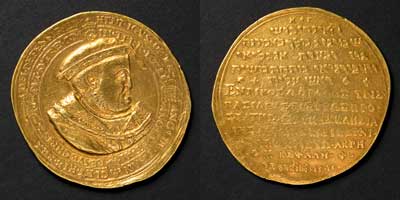 The struggle between the Protestant and Catholic churches, which dominated domestic and international affairs over the centuries, is covered by Hunter’s collection of British medals. Henry VIII, angry at Rome for refusing his divorce of Catherine of Aragon, cast aside the Catholic Church and declared himself head of the Church of England. His successor, Mary, reversed the policy only for Elizabeth I to revert back to Protestantism upon her accession. James II, a Catholic, ruled by what he described as ‘divine right’. Nevertheless, he was forced from the throne in the Glorious Revolution of 1688 to make way for William, a Dutchman and Protestant, to become king. The 1701 Act of Settlement prohibited Catholics from ascending the British throne.
The struggle between the Protestant and Catholic churches, which dominated domestic and international affairs over the centuries, is covered by Hunter’s collection of British medals. Henry VIII, angry at Rome for refusing his divorce of Catherine of Aragon, cast aside the Catholic Church and declared himself head of the Church of England. His successor, Mary, reversed the policy only for Elizabeth I to revert back to Protestantism upon her accession. James II, a Catholic, ruled by what he described as ‘divine right’. Nevertheless, he was forced from the throne in the Glorious Revolution of 1688 to make way for William, a Dutchman and Protestant, to become king. The 1701 Act of Settlement prohibited Catholics from ascending the British throne.
Cavaliers and Roundheads
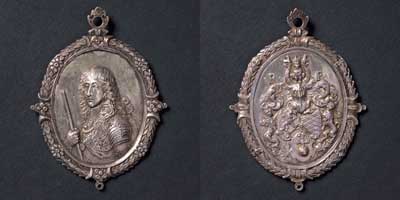 The English Civil War was not just one war, but three between 1642 and 1651. Nor did the conflict only affect England but also devastated Scotland, Wales and Ireland. It was a political and religious war that divided counties, towns, villages and even families. A series of brutal and pitiless campaigns saw the defeat of the Royalist cause, the dissolution of the monarchy and regicide of King Charles I, the victory of the Parliamentarian New Model Army and rise of Oliver Cromwell to Lord Protector of the Commonwealth. Extraordinary personalities became famous on both sides. They were commemorated on medals that were given out as rewards, mementos and emblems of loyalty.
The English Civil War was not just one war, but three between 1642 and 1651. Nor did the conflict only affect England but also devastated Scotland, Wales and Ireland. It was a political and religious war that divided counties, towns, villages and even families. A series of brutal and pitiless campaigns saw the defeat of the Royalist cause, the dissolution of the monarchy and regicide of King Charles I, the victory of the Parliamentarian New Model Army and rise of Oliver Cromwell to Lord Protector of the Commonwealth. Extraordinary personalities became famous on both sides. They were commemorated on medals that were given out as rewards, mementos and emblems of loyalty.
The Jacobite Dream
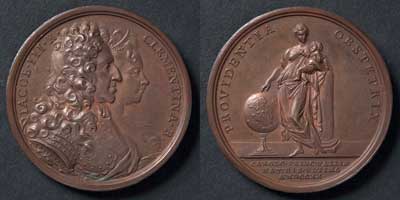 For many today, the Jacobite Risings of 1708, 1715 and 1745 conjure up romantic notions of reclaiming lost kingdoms. But in reality these adventures were a series of bloody failures for the exiled Stuart dynasty who claimed the throne from abroad. For many of their supporters, the Stuarts were freedom fighters who were being denied their God-given right to rule. But for those that opposed them, Jacobites were traitors who threatened the stability of the nation. Many medals were produced on both sides relating to this period. This selection displays mainly commemorative medals, but also those that were intended to show an individual’s allegiance or be used as propaganda for the Stuart cause.
For many today, the Jacobite Risings of 1708, 1715 and 1745 conjure up romantic notions of reclaiming lost kingdoms. But in reality these adventures were a series of bloody failures for the exiled Stuart dynasty who claimed the throne from abroad. For many of their supporters, the Stuarts were freedom fighters who were being denied their God-given right to rule. But for those that opposed them, Jacobites were traitors who threatened the stability of the nation. Many medals were produced on both sides relating to this period. This selection displays mainly commemorative medals, but also those that were intended to show an individual’s allegiance or be used as propaganda for the Stuart cause.
Other Highlights
 The Gunpowder Plot was an attempt to blow up the House of Lords on the state opening of Parliament on 5 November 1605. The snake represents the Jesuits, who were blamed for the plot, gliding through the lilies of France and roses of England. The inscription reads: ‘He who concealed himself is detected’.
The Gunpowder Plot was an attempt to blow up the House of Lords on the state opening of Parliament on 5 November 1605. The snake represents the Jesuits, who were blamed for the plot, gliding through the lilies of France and roses of England. The inscription reads: ‘He who concealed himself is detected’.
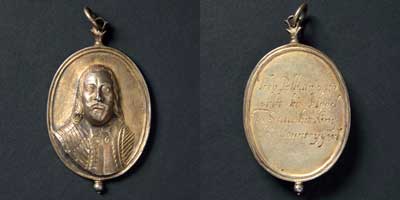 This unique medal depicts James Graham, 1st Marquess of Montrose (1612 - 1650), who supported the Royalist cause during the English Civil War. After defeat at the Battle of Carbisdale on 27 April 1650, Montrose was handed over to Parliamentarian forces. He was sentenced to death and hanged in Edinburgh on 21 May 1650.
This unique medal depicts James Graham, 1st Marquess of Montrose (1612 - 1650), who supported the Royalist cause during the English Civil War. After defeat at the Battle of Carbisdale on 27 April 1650, Montrose was handed over to Parliamentarian forces. He was sentenced to death and hanged in Edinburgh on 21 May 1650.
Explore the Collection
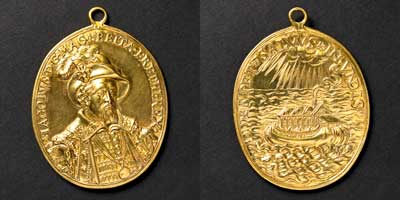 Find out more about Dr William Hunter’s collection of medals.
Find out more about Dr William Hunter’s collection of medals.
Events
Hunterian Insight Talks
Moments in History
Date: 29 March 2016
Time: 1.00pm
Speaker: Jesper Ericsson, The Hunterian
Location: Hunterian Art Gallery
Moments in History: Medals as Propaganda
Date: 7 June 2016
Time: 1.00pm
Speaker: Jesper Ericsson, The Hunterian
Location: Hunterian Art Gallery
Promiscuously Bought Vanities? William Hunter's British Medals
Date: 18 October 2016
Time: 1.00pm
Speaker: Jesper Ericsson, The Hunterian
Location: Hunterian Art Gallery
Acknowledgements
 Moments in History was made possible by the Scottish Government’s Recognition Scheme, administered by Museums Galleries Scotland.
Moments in History was made possible by the Scottish Government’s Recognition Scheme, administered by Museums Galleries Scotland.
Staff of The Hunterian, in particular Dr Donal Bateson, Reader in Numismatics and Senior Curator.
Sam Dyer, University of Glasgow Photographic Unit.

